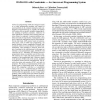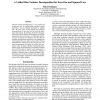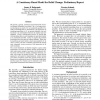AAAI
2000
15 years 2 months ago
2000
This paper demonstrates qualitative spatial reasoning techniques in a real-world diagrammatic reasoning task: Course-of-Action (COA) diagrams. COA diagrams are military planning d...
AAAI
2000
15 years 2 months ago
2000
A central problem in qualitative reasoning is understanding how people reason about space and shape with diagrams. We claim that progress in diagrammatic reasoning is being slowed...
AAAI
2000
15 years 2 months ago
2000
In this paper, we present PQSOLVE, a distributed theorem-prover for Quantified Boolean Formulae. First, we introduce our sequential algorithm QSOLVE, which uses new heuristics and...
101
click to vote
AAAI
2000
15 years 2 months ago
2000
The complexity of numerical domain partitioning depends on the number of potential cut points. In multiway partitioning this dependency is often quadratic, even exponential. There...
AAAI
2000
15 years 2 months ago
2000
We consider the compilation of different reasoning tasks into the evaluation problem of quantified boolean formulas (QBFs) as an approach to develop prototype reasoning systems us...
130
click to vote
AAAI
2000
15 years 2 months ago
2000
Answer-set programming (ASP) has emerged recently as a viable programming paradigm well attuned to search problems in AI, constraint satisfaction and combinatorics. Propositional ...
102
click to vote
AAAI
2000
15 years 2 months ago
2000
Self-localisation is an essential competence for mobile robot navigation. Due to the fundamental unreliability of dead reckoning, a robot must depend on its perception of external...
AAAI
2000
15 years 2 months ago
2000
The bias-variance decomposition is a very useful and widely-used tool for understanding machine-learning algorithms. It was originally developed for squared loss. In recent years,...
111
click to vote
AAAI
2000
15 years 2 months ago
2000
We present a general, consistency-based framework for belief change. Informally, in revising K by , we begin with and incorporate as much of K as consistently possible. Formally, ...
105
click to vote
AAAI
2000
15 years 2 months ago
2000
Changing the way users interact with their data is the principal objective of the Listen, Communicate, Show (LCS) paradigm. LCS is a new paradigm being applied to Marine Corps tac...



